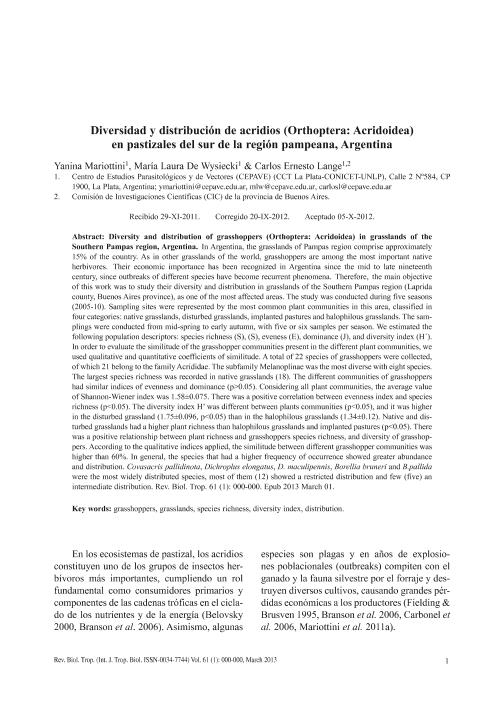Artículo
Diversidad y distribución de acridios (Orthoptera: Acridoidea) en pastizales del sur de la región pampeana, Argentina
Título:
Diversity and distribution of grasshoppers (Orthoptera: Acridoidea) in grasslands of the Southern Pampas region, Argentina
Fecha de publicación:
07/2013
Editorial:
Universidad de Costa Rica
Revista:
Revista de Biología Tropical
ISSN:
0034-7744
Idioma:
Español
Tipo de recurso:
Artículo publicado
Clasificación temática:
Resumen
In Argentina, the grasslands of Pampas region comprise approximately 15% of the country. As in other grasslands of the world, grasshoppers are among the most important native herbivores. Their economic importance has been recognized in Argentina since the mid to late nineteenth century, since outbreaks of different species have become recurrent phenomena. Therefore, the main objective of this work was to study their diversity and distribution in grasslands of the Southern Pampas region (Laprida county, Buenos Aires province), as one of the most affected areas. The study was conducted during five seasons (2005-10). Sampling sites were represented by the most common plant communities in this area, classified in four categories: native grasslands, disturbed grasslands, implanted pastures and halophilous grasslands. The samplings were conducted from mid-spring to early autumn, with five or six samples per season. We estimated the following population descriptors: species richness (S), (S), eveness (E), dominance (J), and diversity index (H´). In order to evaluate the similitude of the grasshopper communities present in the different plant communities, we used qualitative and quantitative coefficients of similitude. A total of 22 species of grasshoppers were collected, of which 21 belong to the family Acrididae. The subfamily Melanoplinae was the most diverse with eight species. The largest species richness was recorded in native grasslands (18). The different communities of grasshoppers had similar indices of evenness and dominance (p>0.05). Considering all plant communities, the average value of Shannon-Wiener index was 1.58±0.075. There was a positive correlation between evenness index and species richness (p<0.05). The diversity index H’ was different between plants communities (p<0.05), and it was higher in the disturbed grassland (1.75±0.096, p<0.05) than in the halophilous grasslands (1.34±0.12). Native and disturbed grasslands had a higher plant richness than halophilous grasslands and implanted pastures (p<0.05). There was a positive relationship between plant richness and grasshoppers species richness, and diversity of grasshoppers. According to the qualitative indices applied, the similitude between different grasshopper communities was higher than 60%. In general, the species that had a higher frequency of occurrence showed greater abundance and distribution. Covasacris pallidinota, Dichroplus elongatus, D. maculipennis, Borellia bruneri and B.pallida were the most widely distributed species, most of them (12) showed a restricted distribution and few (five) an intermediate distribution
Palabras clave:
Grasshoppers
,
Species Richness
,
Diversity Indices
,
Distribution
,
Grasslands
Archivos asociados
Licencia
Identificadores
Colecciones
Articulos(CEPAVE)
Articulos de CENTRO DE EST.PARASITOL.Y DE VECTORES (I)
Articulos de CENTRO DE EST.PARASITOL.Y DE VECTORES (I)
Citación
Mariottini, Yanina; de Wysiecki, Maria Laura; Lange, Carlos Ernesto; Diversidad y distribución de acridios (Orthoptera: Acridoidea) en pastizales del sur de la región pampeana, Argentina; Universidad de Costa Rica; Revista de Biología Tropical; 61; 1; 7-2013; 111-124
Compartir
Altmétricas




